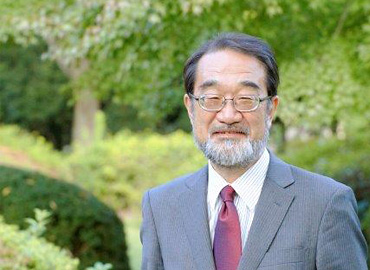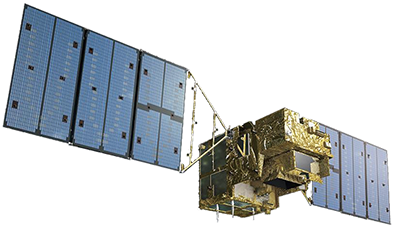理事長メッセージ
[2] GOSATのセンサーと観測方法
[3] GOSATデータの解析方法
[4] データの定常処理と提供
[5] GOSATのプロダクト
[6] GOSATプロダクトの検証
[7] プロジェクトに関する情報発信と研究公募
[8] 体制と今後の予定

国立環境研究所 元理事長 住 明正
(在任:2013年4月1日 - 2017年3月31日)
国立環境研究所は、環境行政の科学的・技術的基盤を支え、幅広い環境研究に学際的かつ総合的に取り組む国内唯一の研究所として、1974年に国立公害研究所として発足しました。現在、環境問題は公害だけではなく、資源の乱開発や浪費による環境破壊や汚染、生物多様性の喪失、地球温暖化など、長期にわたる人間活動に起因する地球規模の問題へと変化してきました。こうした流れの中、人工衛星による地球観測は不可欠な手段となっています。
90 年代後半、日本における人工衛星による地球観測は高揚期を迎えていました。ADEOS、ADEOS-II、TRMMなどの地球観測衛星が開発・運用されたのがこの頃です。国立環境研究所(当時は国立公害研究所、以下「国環研」)では、ADEOS、ADEOS-IIという衛星に、オゾンを中心とする成層圏の微量成分を観測するセンサを提案し運用してきました。さらに後継のセンサを提案していました。そのセンサではオゾンのみならず大気中の微量成分であるCO2 も計測することとなっていました。
2000年代に入ると京都議定書が採択され、日本全体でも温室効果ガス観測に関する関心が高まってきました。そこで、宇宙開発事業団NASDA(当時)、環境省、国環研が、観測の必要性をふまえて新たな温室効果ガス観測技術衛星プロジェクトを発足させました。それが「GOSATプロジェクト」です。
このプロジェクトは孤軍奮闘の連続でした。同時期にあがるはずのOCO の打ち上げ失敗も、その後の国環研のGOSATプロジェクトに大きな影響を与えました。数多くの海外研究者のGOSATプロジェクトへの参加というプラスの半面、データ処理業務を維持・改善しつつ彼等に伍して研究成果を出す必要がありました。しかし、研究者数の不足という条件の下、現在は確実に成果を出し、今や「GOSATプロジェクト」は国環研として誇れるプロジェクトの一つとなりました。
GOSAT は一つの教訓を与えてくれました。衛星ミッションの立ち上げに関する教訓です。開発スタート時の技術的可能性が100%である観測ミッションを選べば安心ですが、それでは衛星打ち上げ時の世間の要請にこたえるには不十分であり、観測ミッションとしては陳腐化していることになります。衛星が打ちあがった時に旬のサイエンスができるためには、技術の進展を見通し、ある程度の技術的なリスクを克服する覚悟と見通しのもと、意欲的なミッションに着手せざるを得ないということです。
今後は観測運用業務とデータ活用とのバランスを課題としながら、「GOSATプロジェクト」の成果が社会の役に立つように努力するとともに、後継機の「GOSAT-2」プロジェクトに繋げたいと考えています。
2015年 夏
人工衛星により拓かれた温室効果ガス観測
GOSATミッション―これまで、これから
理事長メッセージ

GOSAT(いぶき)の歴史を追ってみました。




観測データの一般提供開始
「いぶき」による観測データの解析結果(二酸化炭素・メタン濃度等)について初期検証作業が完了したのに伴い、当該データの一般提供を開始しました。
16 Feb, 2010
定常運用が無事終了しました。
定常的に観測を継続する期間(国内外の利用者・研究者に観測データを定常的に提供)が無事終了し、後期利用運用 (設計寿命を超えて観測を継続する期間 )に突入しました。
Jan, 2014
打ち上げ成功
H-IIAロケット15号機により、種子島宇宙センターから打ち上げられました。
23 Jan, 2009
初の観測データを取得
初期機能確認の中で、「いぶき」搭載の温室効果ガス観測センサ(TANSO-FTS)及び雲・エアロソルセンサ(TANSO-CAI)の立上げを行い、初の観測データを取得しました。
Feb, 2009
President's Greeting
The past, present and future of the GOSAT Mission
Former NIES President Akimasa SUMI
(In office: April 1st, 2013 - March 31, 2017)
National Institute for Environmental Studies (NIES) was established in 1974 as the sole institute in Japan for integrated, interdisciplinary research in the broad fields of environmental studies, to provide the scientific and technical basis for the policy-making administration. The issues we face now have transitioned from those of extreme pollution in particular regions, to those of a long-term, anthropogenic, and global nature - such as environmental destruction and contamination, loss of biodiversity, and global warming - caused by exploitation and over-use of natural resources. This situation has made global observation by satellites imperative.
In Japan, the late 90s was a momentous and exciting period for observation by satellites. Satellites such as ADEOS, ADEOS-II, TRMM were developed and put into operation. NIES proposed and realized a sensor to observe stratospheric trace gases such as ozone on ADEOS and ADEOS-II, as well as a subsequent sensor to additionally observe CO2.
In the 2000s, greenhouse gases observation had attracted a growing interest globally, following the adoption of the Kyoto Protocol on emission reduction targets. In this context, JAXA (Japan Aerospace Exploration Agency), MOE (Ministry Of the Environment), and NIES began a new project, namely the GOSAT (“Greenhouse gases Observing SATellite) Project, to respond to the growing necessity for observation.
GOSAT project has a lot of troubles at the early stage. The unsuccessful launch of OCO in the same year also greatly affected the project. One good thing was the engagement of a large number of foreign researchers. However, we had to achieve the same results while maintaining and improving our data processing system. Today, GOSAT team has achieved an optimal level of performance in a context of insufficient research resources, positioning itself as one of the projects of which NIES can be most proud.
GOSAT gives us a lesson on how a satellite mission should be. If you commit to a mission with 100% feasibility at its inception, while its immediate success may be largely certain, in subsequent times it is unlikely to remain in step with the circumstances and expectations of contemporaneous society due to issues of obsolescence. It is thus imperative that a mission be sufficiently ambitious to remain useful to current science, following the launch period, by predicting technological developments and instilling preparedness for the likelihood of technical risks.
Today, GOSAT project is at a stage of expanding its outcomes towards a better human society, maintaining its observational operation and paving the way for the launch of the upcoming successor GOSAT-2.
summer 2015
サイトポリシー | プライバシーポリシー | 関連リンク | 用語略語集
Copyright © National Institute for Environmental Studies. All Rights Reserved.











